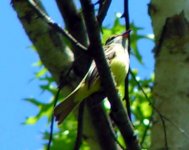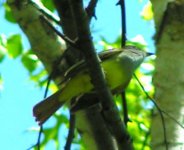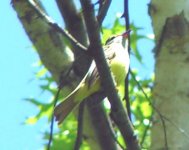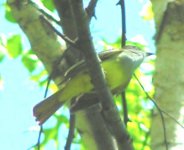The thing that discourages me from thinking this is a Western kingbird is that the bib in the photos is so much darker gray than any Western I've seen, but more importantly that there are no "white sidewalls" to the tail, which even juvenile birds of this sp have, not to mention that this tail is definitely not black in the photos.
In the absence of hearing this bird singing, it sure looks more like a Myiarchus to me than a Tyrannus (I've only seen Great-crested once, two years ago). In Hal's brightened photos, the tail is starting to have a rufous tinge to the center with darker edges, which also leans more to Myiarchus.
Speaking of Myiarchus, I was just told I reported the first Dusky-capped flycatcher (Myiarchus tuberculifer) for our northern AZ county. This is a Mexican species that is seen widely throughout southern AZ but rarely north of Phoenix and never on "the Rim" (2,000' Mogollon Rim that geographically divides the eastern half of the state between north and south). We have Ash-throated flycatcher (Myiarchus cinerascens) all the time here in our yard (we have two as I "speak"), but had I not heard the Dusky-capped singing, it is otherwise almost indistinguishable from Ash-throated in the field.
Lassa, as Charles wondered, did you hear the bird vocalize at all?








